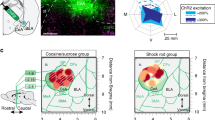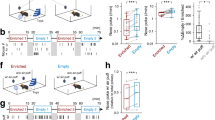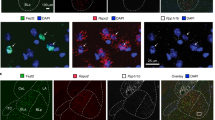Abstract
The nucleus accumbens mediates both appetitive motivation for rewards and fearful motivation toward threats, which are generated in part by glutamate-related circuits organized in a keyboard fashion. At rostral sites of the medial shell, localized glutamate disruptions typically generate intense appetitive behaviors in rats, but the disruption incrementally generates fearful behaviors as microinjection sites move more caudally. We found that exposure to stressful environments caused caudal fear-generating zones to expand rostrally, filling ∼90% of the shell. Conversely, a preferred home environment caused fear-generating zones to shrink and appetitive-generating zones to expand caudally, filling ∼90% of the shell. Thus, the emotional environments retuned the generation of motivation in corticolimbic circuits.
This is a preview of subscription content, access via your institution
Access options
Subscribe to this journal
Receive 12 print issues and online access
$209.00 per year
only $17.42 per issue
Buy this article
- Purchase on Springer Link
- Instant access to full article PDF
Prices may be subject to local taxes which are calculated during checkout



Similar content being viewed by others
References
Maldonado-Irizarry, C.S., Swanson, C.J. & Kelley, A.E. J. Neurosci. 15, 6779–6788 (1995).
Reynolds, S.M. & Berridge, K.C. J. Neurosci. 22, 7308–7320 (2002).
Reynolds, S.M. & Berridge, K.C. Eur. J. Neurosci. 17, 2187–2200 (2003).
Stratford, T.R. & Kelley, A.E. J. Neurosci. 17, 4434–4440 (1997).
Owings, D.H. & Morton, E.S. Animal Vocal Communication: a New Approach (Cambridge University Press, Cambridge, 1998).
Reynolds, S.M. & Berridge, K.C. J. Neurosci. 21, 3261–3270 (2001).
Wilkie, D.M., MacLennan, A.J. & Pinel, J.P. J. Exp. Anal. Behav. 31, 299–306 (1979).
Valenstein, E.S., Cox, V.C. & Kakolewski, J.W. Science 163, 1084 (1969).
Berridge, K.C. Psychopharmacology (Berl.) 191, 391–431 (2007).
Berridge, K.C. & Robinson, T.E. Brain Res. Brain Res. Rev. 28, 309–369 (1998).
Kapur, S. Am. J. Psychiatry 160, 13–23 (2003).
Kringelbach, M.L. & Rolls, E.T. Prog. Neurobiol. 72, 341–372 (2004).
Robinson, T.E. & Berridge, K.C. Annu. Rev. Psychol. 54, 25–53 (2003).
Everitt, B.J. & Robbins, T.W. Nat. Neurosci. 8, 1481–1489 (2005).
Acknowledgements
We thank S. Mahler and E. Jackson for comments on an earlier version of the manuscript and P. Hoberg and M. DiMondo for assistance with histology. Finally, we are grateful to the musician and former University of Michigan student Iggy Pop for developing art that is also of use to science. This research was supported by US National Institutes of Health grants (MH63649 and DA015188 to K.C.B.) and by a National Research Service Award fellowship to S.M.R. (DA14679).
Author information
Authors and Affiliations
Corresponding authors
Supplementary information
Supplementary Text and Figures
Supplementary Figures 1–7, Methods, Results (PDF 2575 kb)
Rights and permissions
About this article
Cite this article
Reynolds, S., Berridge, K. Emotional environments retune the valence of appetitive versus fearful functions in nucleus accumbens. Nat Neurosci 11, 423–425 (2008). https://doi.org/10.1038/nn2061
Received:
Accepted:
Published:
Issue Date:
DOI: https://doi.org/10.1038/nn2061
This article is cited by
-
Activation patterns in male and female forebrain circuitries during food consumption under novelty
Brain Structure and Function (2024)
-
Neural valuation of rewards and punishments in posttraumatic stress disorder: a computational approach
Translational Psychiatry (2023)
-
Nucleus accumbens core single cell ensembles bidirectionally respond to experienced versus observed aversive events
Scientific Reports (2023)
-
An intein-split transactivator for intersectional neural imaging and optogenetic manipulation
Nature Communications (2022)
-
Cerebellar glutamatergic system impacts spontaneous motor recovery by regulating Gria1 expression
npj Regenerative Medicine (2022)



